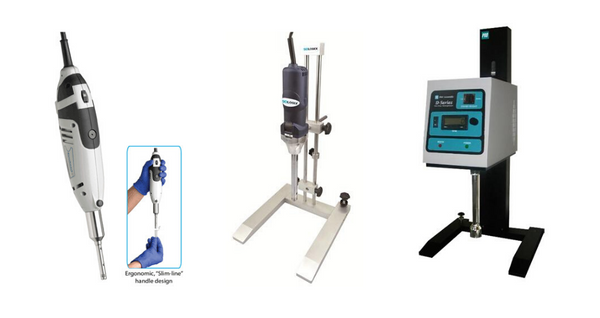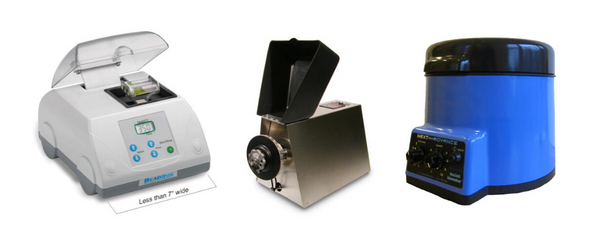For many applications, both a rotor-stator homogenizer and a bead mill homogenizer may be up to the task. However, these two technologies vary in many respects and one may be more suitable for your application than the other.
In this article, we’ll take a look at the pros and cons of each technology. We’ll also provide a summary of which types of applications each technology is most suitable for.
Rotor-Stator Homogenizers
A rotor-stator homogenizer processes samples using rotary mechanical force. The rotor (a rotating metal shaft) spins rapidly inside the stator (a stationary metal casing). When the rotor rotates, it causes a suction effect. The sample is drawn in between the rotor and stator, and subjected to high shear forces.

Left to right: A D1000 Handheld Homogenizer, a D500 Homogenizer, and a PRO400 Benchtop Homogenizer.
Pros of Rotor-Stator Homogenizers
- They allow for the processing of a large range of sample sizes as you can switch between probes (for example, a single model could process 30 microliters or 30 liters).
- Larger models are available with no maximum volume so they are good for scaleup.
- Rotary evaporators are fast and efficient for processing single samples.
- They are ideal for liquid applications.
- There are different types of probes available, for example, saw-tooth for fibrous samples.
Cons of Rotor-Stator Homogenizers
- Most rotor-stator systems only process a single sample at a time. Those which process multiple samples are relatively expensive.
- Rotor-stator homogenizers create heat, so cooling is need for heat-sensitive samples.
- They’re not suitable for solid samples.
- You need to wash probes between uses so multi-sample processing can be time-consuming and labor-intensive.
- You may need to pre-process hard or fibrous samples.
Bead Mill Homogenizers
When using a bead mill homogenizer, you place your sample in a tube along with beads. The tubes are shaken vigorously, and collisions between the beads, particles, and walls of the tube grind and homogenize your sample.

Left to right: A BeadBug™, a Mini-Beadbeater, and a Bullet Blender®.
Pros of Bead Mill Homogenizers
- You can use them to process multiple samples at once so they’re good for high-throughput applications.
- They’re suitable for liquid or solid samples.
- Disposable tubes are used, meaning there is almost no chance of contamination.
- The tubes are closed so the risk of aerosolization is nearly eliminated.
- Different types of beads are available for various uses, broadening the potential application range.
- Some are designed such that they can be used for infectious or hazardous materials.
Cons of Bead Mill Homogenizers
- Laboratory-scale bead mill homogenization is only suitable for small samples. A few grams or milliliters is all you can usually process in a single tube.
- Small amounts of the bead material may find its way into your sample, which might be a concern for some applications.
Summary of Rotor-Stator Homogenizers Versus Bead Mill Homogenizers
In general, rotor-stator homogenizers are more suitable for low-throughput applications involving liquid samples, although those samples can be quite large – many gallons at a time can be processed in batch. Since the process can be easily scaled, a rotor-stator homogenizer would be good for processes that ultimately need to be scaled up.
If you’re processing multiple samples at a time, having to clean the probe between each use can be time-consuming and cumbersome, especially when contamination is a concern. While there are rotor-stator models capable of high throughput, these tend to be expensive.
For high-throughput applications involving small sample sizes, a bead mill is usually a better option. They are also more suitable if you are dealing with temperature-sensitive samples, as they tend to generate less heat than a rotor-stator homogenizer. A bead mill homogenizer is more favorable if cross-contamination is a significant concern.
Some of the main features of both technologies are summarized below:
|
Rotor-Stator Homogenizer |
Bead Mill Homogenizer |
|
|
Particle Size |
Min particle size: ~2–3 µm |
Min particle size: ~500 nm |
|
Sample Size |
0.03 mL and up |
1 μL – 200 mL |
|
Max. Viscosity |
~ 10,000 cP |
~ 100 cP |
|
Throughput |
Generally low |
Generally high |
|
Scaleup |
Easy to scale up |
Not very suitable for scaleup |
|
Heat Generated |
Some heat generated |
Very little to some heat generated |
|
Ease of Use |
Easy to set up and good for single samples |
Simple to set up and ideal for multiple samples |
|
Cleaning |
Fairly simple to clean between uses |
Usually uses single-use tubes so little cleaning is required |
The suitability of one technology over another is highly dependent on your application. Here are some common applications of these two homogenizer technologies:
|
Rotor-Stator Homogenizer |
Bead Mill Homogenizer |
|
Emulsification Suspensions General Particle Size Reduction (> 1 µm) Cell lysis Tissue homogenization Cell isolation |
Tissue homogenization Cell lysis Tissue disruption / Cell isolation Organelle extraction Particle size reduction (small samples only) |
